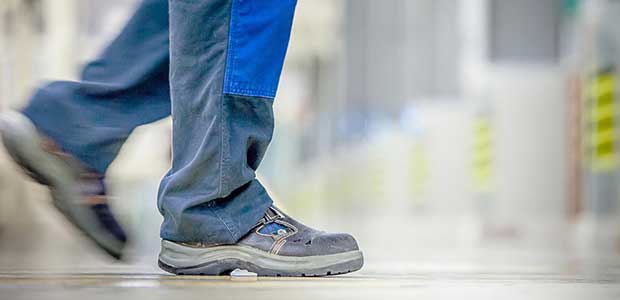
Choosing the Right Safety Shoe for Your Industry
If footwear does not provide sufficient support, the worker may not wear it leading to several opportunities for injury.
- By Jane Gonda
- Oct 01, 2020
In contrast to jobs in the construction industry, where work often takes place outdoors, there are plenty of employees in that generally work indoors in large warehouses or production halls with plain floors that form their workplace.
On average, it can be assumed that a warehouse clerk covers about 20,000 steps per day. Depending on individual body size and stride length, this corresponds to a distance of nine to 12 miles, or almost a half marathon per day. It is obvious that such an activity tires the muscles and strains the joints and ligaments. Especially if the footwear does not provide sufficient support.
Why Protect the Foot?
Other than our hands, our feet can be our most used tool with workers and employees on their feet all day long. According to the U.S. Bureau of Labor Statistics, there are over 45,000 foot injuries each year that lead to days away from work. These injuries can be moderate, such as blisters, or can be more severe resulting in chronic pain for workers to manage while on the job. Foot injuries can also lead to pain in the legs and back as well.
Other issues that are often related to foot injuries are slips, trips and falls, which make up over 240,000 injuries in the workforce. If a worker does not have the correct safety shoe on, it could lead to a slip or trip resulting in much more severe injuries, or even death.
Other reasons to protect the foot include employee comfortability and attitude. If the worker is free of foot pain because they are wearing a correct fitting shoe, they are more likely to be fully engaged with their tasks, comfortable all day long and more likely to have a better attitude with leaders and coworkers.
Standards to Keep in Mind
When choosing a safety shoe, there are standards to keep in mind to find the correct shoe and stay compliant. OSHA has a federal regulation, 29 CFR 1910.136 that clearly states, “The employer shall ensure that each affected employee uses protective footwear when working in areas where there is a danger of foot injuries due to falling or rolling objects, or objects piercing the sole, or when the use of protective footwear will protect the affected employee from an electrical hazard, such as a static-discharge or electric-shock hazard, that remains after the employer takes other necessary protective measures.”
OSHA mandates PPE, but ASTM International is the organization that sets performance requirements for protective footwear in the United States. It is a requisite for safety footwear to comply with ASTM and each five years, committees review the standards to ensure they are comprehensive and up to date, revising if necessary.
The most current safety footwear standards include ASTM F2413-18, the Standard Specification for Performance Requirements for Protective Toe Cap Footwear and ASTM F412-18, the Standard Test Methods for Foot Protection.
The ASTM F2413-18 standard contains basic requirements to assess footwear including:
- Impact resistance for the toe area
- Compression resistance for the toe area
- Metatarsal protection for the metatarsal bones at the top of the foot
- Conductive properties to reduce static electricity buildup and lower the possibility of ignition of explosives, volatile chemicals or fine particulates in the air
- Electric hazard protection when accidentally stepping on live electric wires
- Static dissipative properties to reduce hazards that result from a buildup of static charge where there is risk of accidental contact with live electrical circuits
- Puncture resistance (to protect the bottom of the foot) from sharp penetrating objects
To ensure that the wearer feels completely comfortable and enjoys going to work in safety shoes, complete the assessment above to ensure workers’ shoes have the ability to keep up with all hazards that may be presented to the foot.
The Right Safety Shoe
There are a lot of hazards a shoe needs to protect against, but getting a worker to wear the safety shoe is a first priority. There are several items to consider for the worker when choosing the right safety shoe, below are a few.
Fit. The first item to consider for optimal comfort is correct fit. You should always make sure that the safety shoe does not fit too tight and can be laced to a suitable fit. Instead of "slipping into" the shoe every day, you should lace it up again every morning so that a tight fit on the wearer's foot can be guaranteed. Blistering and painful pressure points can thus be avoided in the first step.
Comfort. It is also important to choose safety shoes with a sufficient level of cushioning. An intermediate sole with cushioning material forms the basis for a comfortable working environment, especially on hard industrial floors. A high energy return ensures reduced fatigue and more energy—all day long. Good cushioning also protects the joints, the back and the whole body. All this leads to less illness and loss of working hours.
Durability. If the safety shoes are subjected to a high daily load, durability also plays a major role. The upper material should be robust, but also lightweight. Soles made of durable material support the wearer significantly longer and ensure that the shoes do not have to be changed after just a few weeks.
To ensure that the wearer feels completely comfortable and enjoys going to work in safety shoes, a sporty look that combines the characteristics of robust safety shoes with those of modern sports shoes is also a great advantage.
This article originally appeared in the October 2020 issue of Occupational Health & Safety.